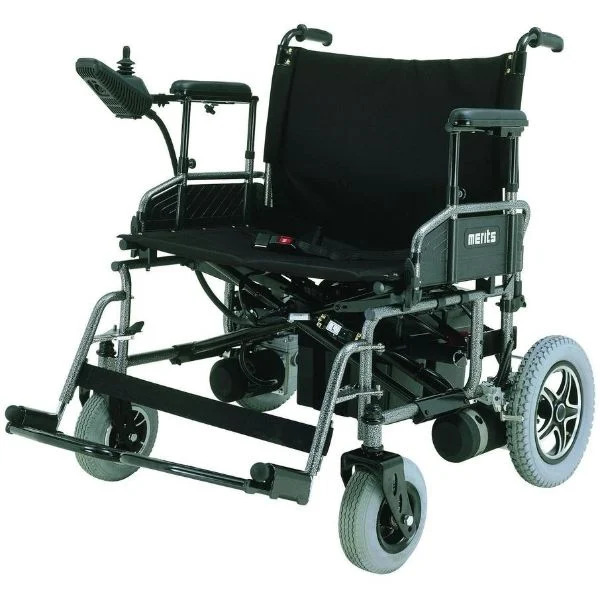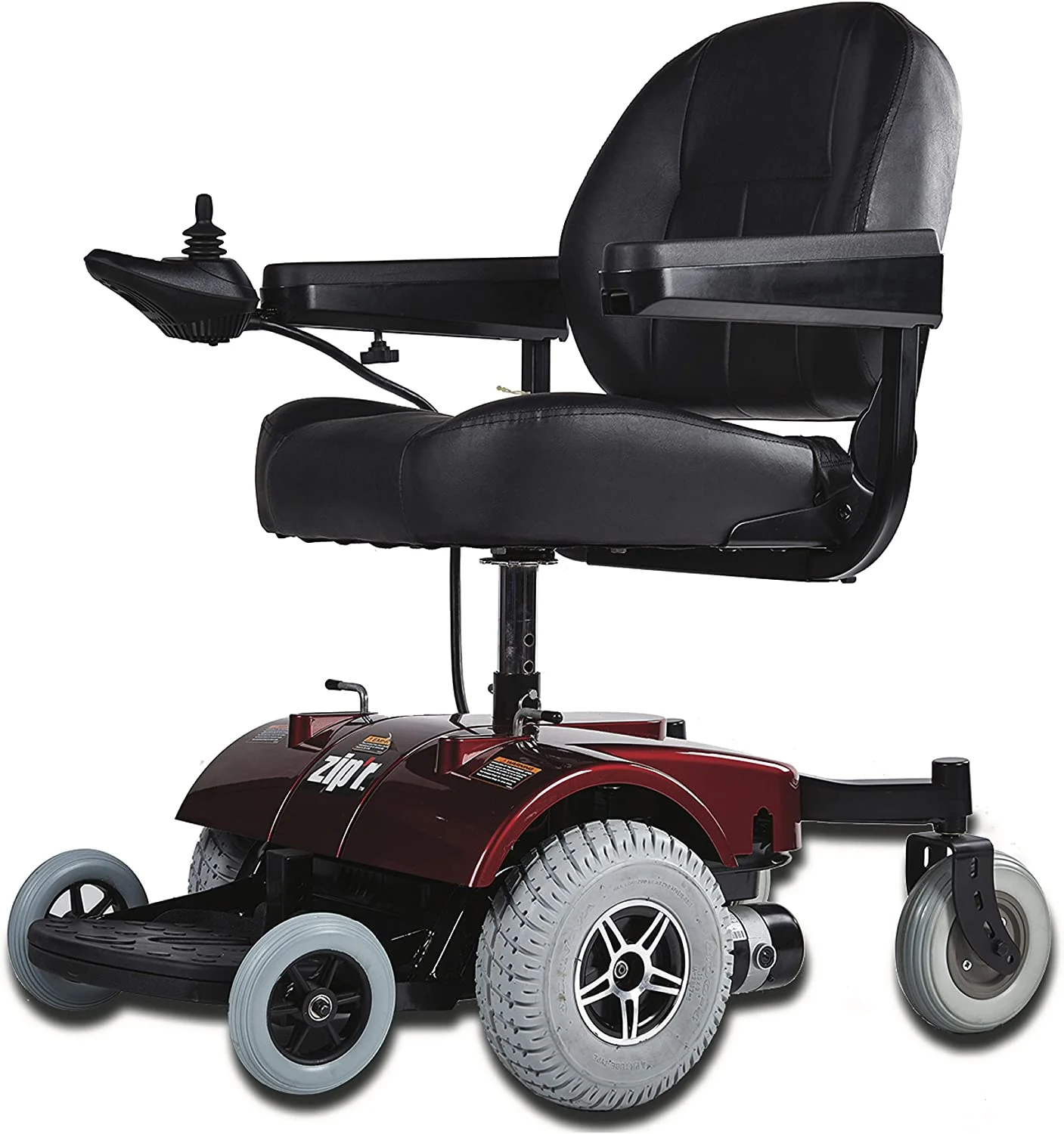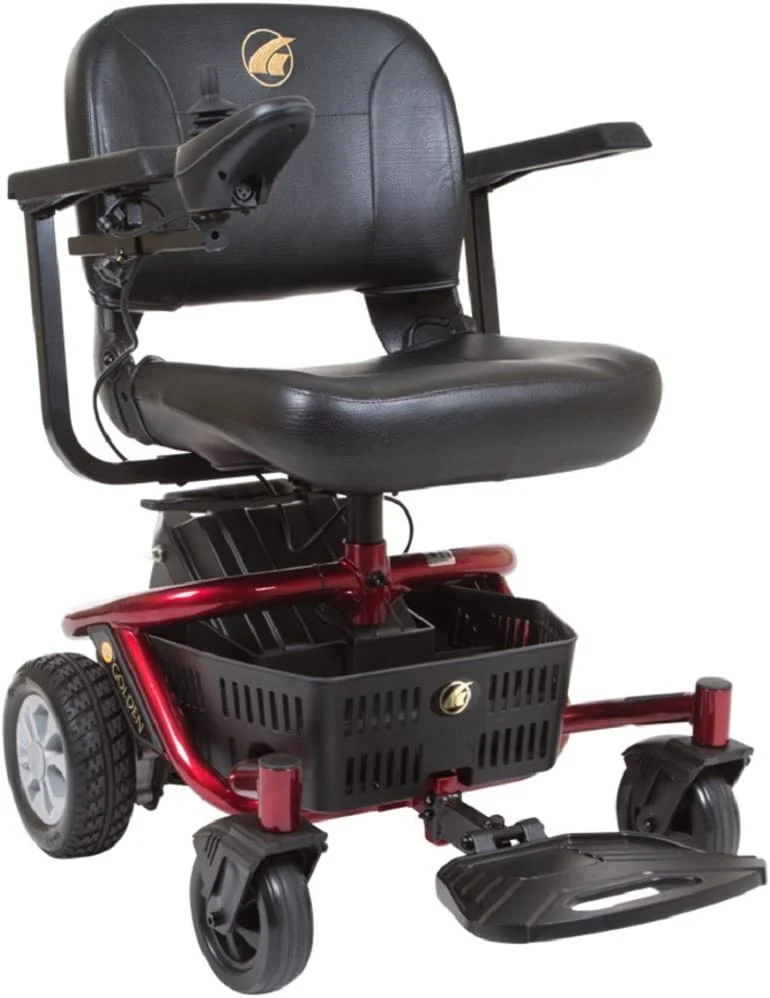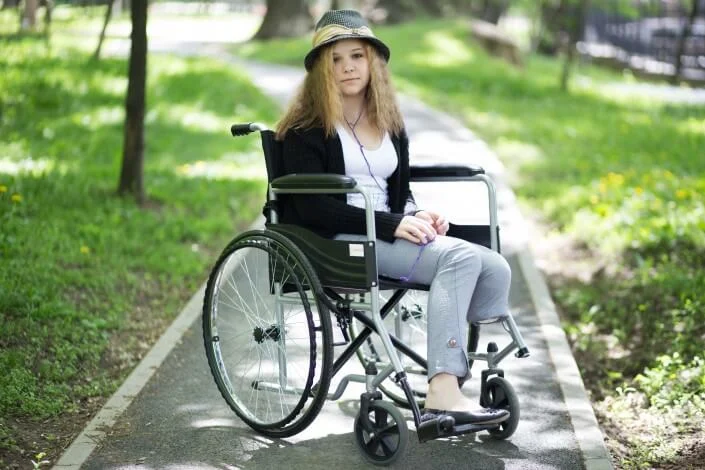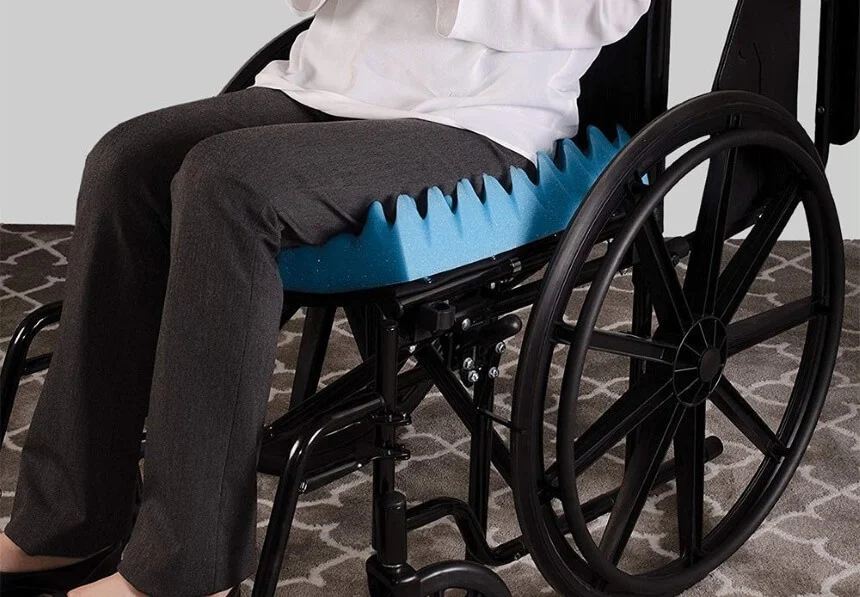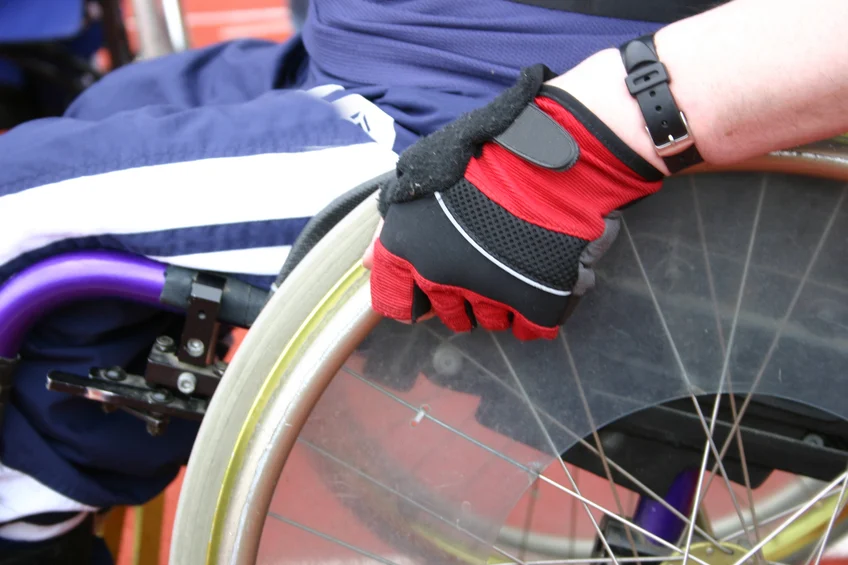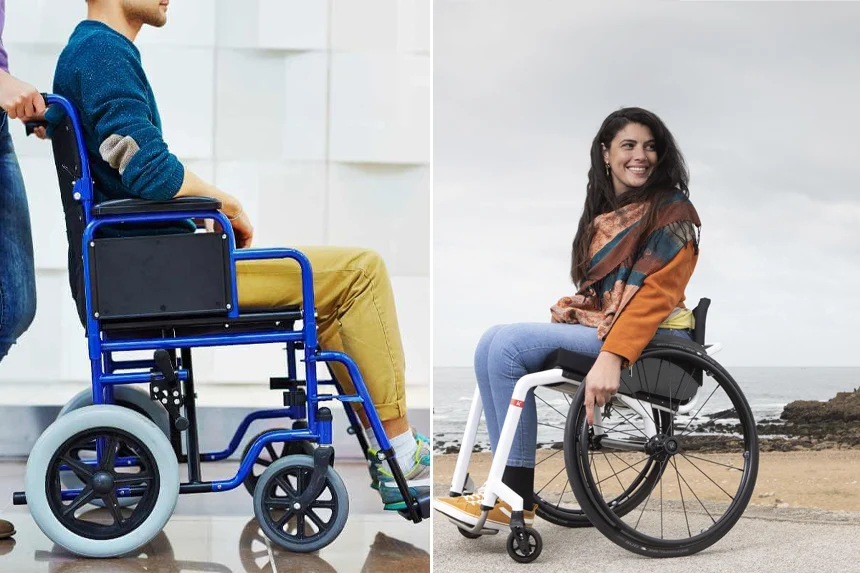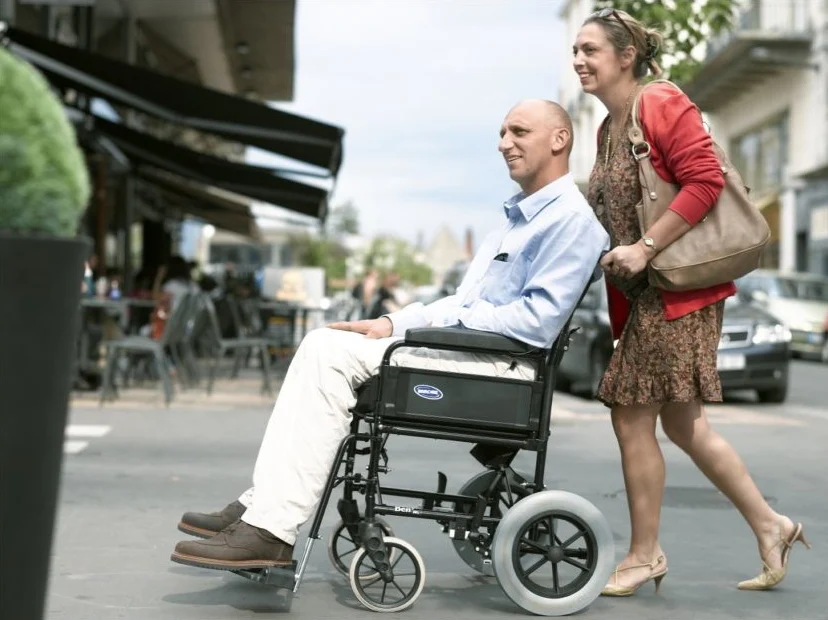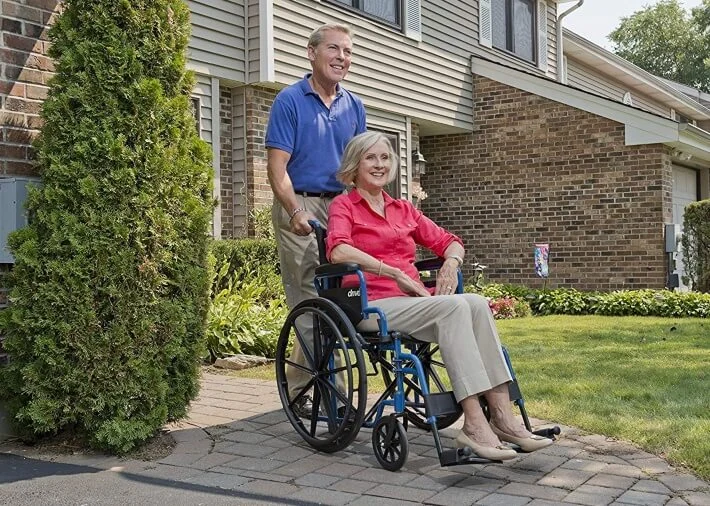Not every wheelchair is suitable for street promenades. If it is not invented for this use, you risk running into a number of troubles: flat tires, a broken frame, rusted metal parts, or even worse – an accident.
To prevent such troubles, wheelchair tires should be super rugged and fat. Anti-tip tires would be a nice touch to feel confident on uneven roads. So we’ve tested 14 models and selected the 6 best power wheelchairs for outdoor use. Our Editor’s Choice nomination took the Sentire Med Forza FCX Deluxe Wheelchair. We also included models made of the most durable and all-weather materials, so neither rain nor the scorching sun would shorten its service life. Of course, all models are equipped with high-capacity batteries not to be left without a means of transportation halfway. Plus, they are all FDA-cleared and air-plane-approved, so only high-quality materials were used in their construction.
By Nan J.Corbo | ✅ Reviewed by Ray Butcher |
SeniorFitness is reader-supported. We may earn a commission through products purchased using links on this page. Learn more about our process here
Quick Summary
- Editor’s Choice: Sentire Med Forza FCX Deluxe Wheelchair “It has non-scuffing, flat-free tires that provide stable support. With a ground clearance of 5″, it gets over most obstacles. The power-adjustable backrest height and intuitive joystick control add convenience to it.”
- Best Bariatric: Merits Health P183 “It has a weight capacity of 700 lbs. and can reach a top speed of 4 mph. It has an impressive 25-mile battery range. It operates on 12.5″ rear tires and 9″ front tires, both of which are foam-filled, so you don’t have to worry about flats, especially when you are outside.”
- Premium Pick: Pride Jazzy 1450 “With its 600 lbs. weight capacity, large 14″ knobby tires, and front spring suspension system, this wheelchair can take on anything you throw at it. It can travel at a rate of 4.5 mph and it offers an impressive battery range of up to 15.7 miles on a single charge.”
- Best Stablity: Zip’r PC Mobility Power Wheelchair “Having six tires, including flat-free and anti-tip tires provides the greatest stability. With buttons for speed control, a horn, a battery meter, and an integrated seatbelt give you an extra sense of security. .”
- Easiest to Disassemble: Golden Technologies New LiteRider Envy “This model can be easily disassembled into 4 parts for easy storing and portability. Plus, it has an under-seat storage basket and a large foot platform..”
- Best Value: Vive Health Folding Power Wheelchair “Having quite a reasonable price, this wheelchair is also FDA-approved. It’s equipped with powerful dual motors, flat-free front tires, and large sport rear tires to safely and smoothly navigate over any terrain. It can speed up to 4 mph. It can support up to 220 pounds.”
Top 6 Best Power Wheelchairs for Outdoor Use Review 2025
1. Editor’s Choice of Wheelchair for Outdoor Use for Seniors
Sentire Med Forza FCX Deluxe Wheelchair
Features
- Max. Speed: 4 mph
- Drive: rear wheel
- Weight Capacity: 360 lbs.
- Seat dimensions: 18 x 17 in.
- Travel Range: 20 miles
- Charging time: 4 hours
- Weight: 67 lbs.
More features: FDA-approved, smart touch joystick, electromagnetic brakes, functional seat belt
The Sentire Med Deluxe Electric Wheelchair is our Editor’s Choice of the best power wheelchairs for outdoor use because it features shock absorbers, solid tires, and intelligent brakes for a smooth ride on all terrains. It’s also really quick to charge, only 4 hours and you’re ready to go again. You’ll be able to go up to 12 miles on a single charge with this wheelchair, making it perfect for all-day outings. Weighing only 67 lbs. and being foldable makes it really easy to transport in your car as well. This wheelchair has a weight capacity of 360 lbs. so it can accommodate larger users. Plus, it is packed with features like a cup holder, storage bags, a battery bag, and travel bags for a power wheelchair that is truly designed for life on the go.
The Sentire Med Deluxe electric wheelchair compares favorably with others from bigger brands like Merits Health. It is more affordable than the Merits Health P183 on this list, yet it has equally impressive features and robust build quality. It is also faster to charge, taking only 4 hours to fully charge as opposed to the 5 hours needed for the Merits Health P183. Overall, the Sentire Med Deluxe electric wheelchair is a better budget-friendly option.
What are our favorite features?
- Fast to charge
- Solid tires
- Shock absorbers for a smooth ride on all terrain
- Long-lasting aluminum alloy frame
- Foldable
- Intelligent electromagnetic brake for safety
- Includes many accessories like a cup holder, storage bags, a battery bag, and travel bags
What could be better?
- The seat can be a bit narrow for some
2. Best Bariatric Wheelchair for Outdoor Use for Seniors
Merits Health P183
Features
- Max. Speed:4 mph
- Travel Range:25 miles
- Drive:rear wheel
- Charging time:5 hours
- Weight Capacity:700 lbs.
- Weight:190 lbs.
- Seat dimensions:26 in wide
More features: FDA-approved, controller, adjustable height flip-up, foam-filled tires, 37 in turning radius
The Merits Health P183 Travel-Ease Folding Electric Wheelchair is the Best Bariatric wheelchair. It has a weight capacity of 700 lbs. so it can accommodate users who are overweight or obese. Plus, it operates on 12.5″ rear tires and 9″ front tires, both of which are foam-filled, so you don’t have to worry about flats when it’s loaded down. Its heavy-duty construction can take a beating, too. It can reach a top speed of 4 mph and has a range of up to 15 miles, making it ideal for long-distance travel. The Mantis Power Electric Wheelchair comes with a programmable controller that has a wide range of selections to suit the needs and demands of different users. Additionally, the auxiliary brakes offer extra safety, which is indispensable when you are outdoors.
The Merits Health P183 Travel-Ease Folding Electric Wheelchair is a better premium upgrade wheelchair compared to all the models on this list. It is the best portable and has the largest weight capacity. It comes with a hefty price tag but it is a worthy investment. Although it can go the longest distance before needing a recharge, it does not offer the best speed.
What do we love it for?
- Huge weight capacity
- Sturdy frame
- Heavy-duty tires
- Foldable
- Swing-away footrests
- The frame is covered by a limited lifetime warranty
- Extra safety is provided by the auxiliary brakes
What were we disappointed with?
- Quite heavy
- Pricey
3. Premium Pick Wheelchair for Outdoor Use for Seniors
Pride Jazzy 1450
Features
- Max. Speed:4.5 mph
- Travel Range:15.7 miles
- Drive:front wheel
- Charging time:4-6 hours
- Weight Capacity:600 lbs.
- Weight:336 lbs.
- Seat dimensions:32 x 28 in
More features: FDA-approved, VRS joystick, flip-up footplate, electronic, regenerative disc brakes, heavy-duty tires, 26.5 turning radius
The Pride Jazzy 1450 Heavy Duty Power Chair is our Premium Pick that can tackle any terrain. With its 600 lbs. weight capacity, large 14″ knobby tires, and front spring suspension system, this wheelchair can take on anything you throw at it. This electric chair has the ability to go through tall grass and tackle more difficult terrains than any other power wheelchair on the market. The Jazzy 1450 can travel at a rate of 4.5 mph, which is faster than most other bariatric power wheelchairs. Additionally, it offers an impressive battery range of up to 15.7 miles on a single charge, so you can be out and about all day without a recharge. Plus, it is super comfortable with its adjustable headrest, lumbar support, and padded seat.
The Pride Jazzy 1450 Heavy Duty Power Chair and the Merit Health P183 electric wheelchairs are among the best premium options on the market. Pride Jazzy is a tad pricier, but it comes with a faster speed. The Merit health P183 offers better value for money as you get easier portability, equally rugged build, bigger weight capacity, and longer distance before recharging.
Why are we impressed?
- Foldable
- Heavy duty tires
- Large footplate
- Comfortable seat
- Good turning radius
- An extensive warranty
What negatives must you be aware of?
- Pricey
- Heavy
- Expensive to travel by plane with it
4. Best Stability Wheelchair for Outdoor Use for Seniors
Zip’r PC Mobility Power Wheelchair
Features
- Max. Speed: 4 mph
- Travel Range: 15 miles
- Drive: mid-wheel
- Charging time: 7 hours
- Weight Capacity: 300 lbs.
- Weight: 160 lbs.
- Seat dimensions: 19.5 x 20 in.
More features: FDA-approved, rear storage pocket, flat-free tires, 20 in. turning radius
The Zip’r PC Power Wheelchair is our Best Stable model because of its unbeatable stability and reliability. With its six tires, this power wheelchair gives you a firm foundation and a great turning radius of 20 inches. The durable, flat-free tires will ensure that you’re not left with punctures or flats no matter where you go. It also has anti-tip tires that give you unbeatable stability on inclines or rough terrain. Its control panel is also easy to use, with buttons for speed control, a horn, and a battery meter. Plus, an integrated seatbelt gives you an extra sense of security. While being secure and stable, it doesn’t forget about your comfort with a roomy, comfortable seat of 19.5 x 20 inches.
The Zip’r PC Power Wheelchair is a great electric wheelchair. It may not have the bells and whistles of the Merit Health P183 and Pride Jazzy 1430 but it is a worthy buy. It is perfect for covering shorter distances and has better portability. The wheelchair has an impressive speed for its size and price point, but its charging time is relatively long.
Why are we impressed?
- 6 tires provide you with a firm foundation
- Puncture-resistant tires
- Sturdy construction
- Integrated seatbelt
- Heavy-duty seat cushions and arm-rests
- Adjustable footrest
- Easy-to-use controls
What negatives must you be aware of?
- A bit heavy
5. Easiest to Disassemble Wheelchair for Outdoor Use for Seniors
Golden Technologies New LiteRider Envy
Features
- Max. Speed: 3.5 mph
- Travel Range: 15.5 miles
- Drive: rear wheel
- Charging time: 6-8 hours
- Weight Capacity: 300 lbs.
- Weight: 123 lbs.
- Seat dimensions: 20 x 18 in.
More features: FDA-approved, under-seat storage, tubular frame design, 2.5 in. ground clearance
The Golden Technologies LiteRider Envy GP162B Power Chair PTC is the Easiest to Disassemble option. The seat, base, and battery pack all break down into four pieces when you pull them apart. The heaviest piece, the base, only weighs 37 lbs. Plus, the power wheelchair can accommodate riders up to 300 lbs and comes with a large footplate so that taller riders can stretch their legs out. The controller of this chair is easy to use and is located on the right armrest for easy steering. It comes in either standard or traditional style. The batteries are fully-harged in 6-8 hours and will last up to 15.5 miles per charge, giving you all-day performance. You can also store personal belongings in the under-seat basket.
An electric wheelchair can be extremely powerful and durably built, but if it’s not comfortable, then the user may not be able to make the most out of its features. The Golden Technologies LiteRider Envy GP162B Power Chair PTC outshines all the wheelchairs on this list in terms of comfort. Besides offering a large footplate to comfortably rest your feet, the Golden Technologies LiteRider Envy GP162B Power Chair PTC outstands offers better value for money than the likes of Pride Jazzy 1450.
What makes it special?
- Quick to disassemble in 4 pieces
- Lightweight and portable
- A basket like under seat storage
- Several color options
- Larger foot platform for taller people
What cons did we find?
- A very sensitive joystick
6. Best Value Wheelchair for Outdoor Use for Seniors
Vive Health Folding Power Wheelchair
Features
- Max. Speed:4 mph
- Travel Range:12 miles
- Drive:rear wheel
- Charging time:4 hours
- Weight Capacity:220 lbs.
- Weight:89 lbs.
- Seat dimensions:16 x 18 in
More features: FDA-approved, joystick controller, 5-year limited guarantee, safety horn button, flat-free tires
The Vive Health Folding Power Wheelchair is the Best Value of the best power wheelchairs. This chair impressed us with its combination of portability, performance, and comfort, and it’s one of the most affordable options on the market. The Folding Power Wheelchair has a weight capacity of 220 pounds and can reach speeds of up to 4 mph, quite a feat for such a reasonably-priced chair. It’s easy to maneuver with an intuitive joystick. The padded seat and armrests are adjustable to ensure your customized comfort, and the flat-free front tires and large rear tires can take on any terrain.
The Vive Health Folding Power Wheelchair has nearly the same features as the Sentire Med Forza FCX Deluxe Wheelchair, yet it comes with a more budget-friendly price tag. They have the same charging time and maximum speed but the Vive Health Folding Power Wheelchair has a narrower travel range than the Sentire Med Forza FCX Deluxe Wheelchair. For a start, the wheelchairs are both solid options but the Vive Health Folding Power Wheelchair offers slightly better value for money.
What do we love it for?
- Reasonable price
- TSA-approved
- Compact
- Folds up easily
- Comfortable seating
What were we disappointed with?
- Heavier than expected
- Batteries are hard to remove
Things to Consider
A power wheelchair for outdoor use needs to be durable and tough enough to handle all kinds of terrain, including gravel, mud, and even snow. But it also needs to be comfortable and easy to control, so you can enjoy your time outdoors. That’s why below, we’ve put together a guide for you on how to choose the best power wheelchair for outdoor use, based on your specific needs.
FDA Clearance
FDA clearance is very important for any medical device company. It shows that the company is serious about making quality products and that they have been tested and proven to be safe and effective. This gives customers confidence in the products they purchase and helps to build a loyal customer base.
A lot of research and development goes into creating new medical devices. The FDA must approve all device designs before they can be sold in the United States. To get FDA approval, a device must go through several rounds of testing, which can take years. After a device is approved, it must be manufactured according to strict guidelines set by the FDA.
Aside from the guarantee of quality and safety, FDA-compliant motorized wheelchairs are usually allowed on airplanes. If you travel often, then you understand how important this is. That’s why in the list of the best power wheelchairs for outdoor use we included only FDA-cleared models.
Maximum Speed
The maximum speed of a motored wheelchair is an important consideration for outdoor use. Most power wheelchairs have a top speed between 4 and 8 mph. The lower speed options may be more appropriate for use on smooth surfaces like sidewalks and paved roads. If you plan on using the wheelchair on rough terrain or going up and down hills, a higher top speed may be necessary.
Travel Range
When choosing a power wheelchair for outdoor use, it’s important to consider the travel range. Depending on the terrain and how much you’ll be using the chair, you’ll want to make sure it has enough power to get you where you need to go.
Most power wheelchairs have a travel range of about 10 miles, but some can go further.
If you plan on using your wheelchair for long distances or on rough terrain, look for one with a higher travel range. Look for wheelchairs that can travel at least 15 miles on a single battery charge.
Some versions can travel up to 30 kilometers, but they tend to be rather costly.
Tires
Pneumatic (air-filled) tires are generally the best choice for outdoor use, as they provide a smoother ride and better shock absorption than solid tires. However, they can be punctured more easily than solid tires, so you’ll need to keep a patch kit handy.
Heavy-duty solid tires are a good choice for occasional outdoor use, but they can be uncomfortable and difficult to maneuver on rough terrain. The heavy-duty wheels are almost maintenance-free and will not wear out with time, but your wheelchair will be bumpier.
Foam-filled tires offer a good middle ground between air-filled and solid tires, as they’re puncture-resistant but still provide a smooth ride.
Flat-free tires are pneumatic tires that have a semi-liquid filler. They are not prone to flat repairs, and their ride is gentler than that of solid tires.
Drive Power
A front-wheel drive is ideal for rugged conditions. You can easily climb steep hills and grades with the wheels positioned slightly ahead of the chair’s body.
Front-wheel drive electric wheelchairs are ideal for traveling over, through, and around dirt, grass, curbs, uneven terrain, and snow. This is due to the fact that the bulk of the weight is behind the driving force. But when turning in these sorts of chairs at your full speed, it’s crucial to be cautious.
Front-wheel power wheelchairs generally only travel 5 miles per hour for safety reasons, but because of their shorter turning radius, they can make tighter turns; in certain cases, they may only have a 25-inch turning radius.
A mid-wheel drive power chairs are among the most maneuverable power chairs on the market. These electric wheelchairs rotate in the middle of the device, much like a spinning top.
In restricted areas, mid-wheel drive electric wheelchairs require far less movement than rear-wheel drive or front-wheel vehicles. They are also one of the simplest to manage. They tackle terrain well with traction and stability when used outdoors.
A rear-wheel drive power chairs have the fastest speed on average. They can reach speeds of up to 10 mph, which is fast enough to keep up with most traffic.
Rear-wheel drive electric wheelchairs have great traction and are able to climb inclines with ease. This is due to the weight distribution of the chair, which puts more weight over the rear wheels.
While rear-wheel drive power chairs aren’t as maneuverable as front-wheel drive chairs, they’re still quite nimble. You’ll be able to navigate around tight spaces without any problems.

The drive power of an electric wheelchair is determined by the wheels that propel the chair.
Turning Radius
The turning radius is one of the most important factors to consider when choosing a power wheelchair for outdoor use.
Some of the best power wheelchairs for outdoor use have a turning radius of fewer than 25 inches, which makes them perfect for maneuvering around tight corners and obstacles, especially indoors.
For uneven terrains or in off-road conditions, look for a model with a larger turning radius that will provide more stability and control.
Charging Time
A power wheelchair can take anywhere from four to eight hours to charge, depending on the type of battery. Lithium-ion batteries, for example, recharge much faster than lead-acid batteries. Most power wheelchairs use lead-acid batteries, which need to be charged overnight to get a full day’s worth of use. All our models can be charged in just 4 to 8 hours using a standard 110-volt household outlet so that you don’t have to wait all day for your chair to be ready to use.
If you don’t use your power wheelchair, it still must be fully charged once a week to maintain the battery’s health.
If you’re using your power wheelchair regularly, it’s a good idea to invest in the second set of batteries so that you can always have one set charged and ready to go.
Weight Capacity
The weight capacity is one of the most important aspects to consider when purchasing a power wheelchair. Not only does the weight limit ensure that the chair can support your body weight, but it also determines how much of a load the chair can carry. This is especially important for those who frequently transport heavy objects or need to use their wheelchair on rough terrain.
Most models have a weight capacity of around 250 pounds, but there are some that can accommodate up to 700 pounds. If you plan on using your wheelchair for long periods of time or carrying heavy loads, then you’ll want to make sure that it has a high weight capacity.
Weight
For many wheelchair users, the weight of a motorized chair is a key factor to consider.
Those who are unable to walk or have difficulty walking may find that a heavier chair is more difficult to maneuver. Heavier chairs also tend to be more expensive.
For users who plan on using their wheelchair primarily outdoors, a lighter-weight chair may be a better option. Lighter chairs are easier to transport and maneuver over uneven terrain. They are also generally less expensive than heavier chairs.
Before First Use
- Practice Before Operating. Until you are confident in operating this car, practice in an open place such as a park with an assistant. Before getting inside or out of the seat, make sure the power is off. Set the speed control to your driving ability. Until you are familiar with the vehicle’s driving characteristics, keep the speed control at its lowest position.
- Set the speed to its lowest position and practice moving forward
- After getting a feeling for moving forward, practice making “S” tums.
- Practice moving in reverse after you’ve mastered “S” turns. Note that, compared to forwarding motion, the vehicle moves more slowly in reverse.
Other Options
Power Mobility Scooter
A mobility scooter is an electric vehicle and mobility aid equivalent or auxiliary to a power wheelchair but configured like a motor scooter.
A power mobility scooter is a fantastic idea for seniors and the disabled, if you’re looking for one, you may read our best 3-wheel mobility scooters or best lightweight mobility scooters to find the best for you.
When motorized they are commonly referred to as power-operated vehicles/scooters, handicap scooters, or electric scooters as well. Non-motorized mobility scooters are less common but are intended for the estimated 60% of wheelchair users who have at least some use of their legs.
Mobility scooters differ from power wheelchairs in that they are usually cheaper, easier to transport, and more customizable. These scooters are built for people who have trouble walking or getting around but don’t need a power wheelchair.
Standing Wheelchair

A standing wheelchair is an incredible device that gives people with disabilities the ability to stand up and walk, even if they can’t do so on their own.
They can be powered by an electric motor, making them ideal for people who can’t walk long distances not only indoors but also outdoors.
Users can sit or stand in their wheelchairs when using these devices. They can be used as both a wheelchair and a standing frame, allowing the user to recline or stand in the chair. With a hydraulic pump or electric-powered assist, they may transition from sitting to standing.
Manual Wheelchair
A manual wheelchair is an old-fashioned type of wheelchair that is propelled by the user through the use of handrails. This type of wheelchair requires a lot of upper body strength and can be difficult to maneuver for people with limited mobility.
A manual wheelchair is a great option for those who are looking for a more affordable way to get around.
If you are looking for such an option, consider checking these best manual wheelchairs to save your money.
However, they are not always the best option for those who live an active lifestyle. If you are someone who enjoys spending time outdoors, or if you need a wheelchair that can handle rough terrain, then a power wheelchair is a better choice.
Wheelchair for Outdoor Use FAQ
Is it possible to use a motored wheelchair in the rain?
It’s not advisable to use any electronic wheelchair in the rain. However, there are some power wheelchairs that come with special features like weather-resistant canopies and covers to protect the user from the elements. If you’re planning on using your power wheelchair in the rain, it is important to keep a few things in mind when using your power wheelchair in wet weather.
Take extra care when going up and down hills. Wet surfaces can be slippery, so it is important to use caution when navigating them.
Make sure that you have a good waterproof cover for your chair. This will help to protect the electronics and moving parts from getting wet.
Be aware of where you are using your chair. Avoid puddles and standing water, as these can damage your chair.
What are the benefits of using a power wheelchair for outdoor use?
There are many benefits of using a power wheelchair for outdoor use.
Power wheelchairs can be used to transport individuals from one place to another, which can save time and energy.
Power wheelchairs can help individuals with mobility issues move around their home and backyard with ease.
Power wheelchairs can help individuals with limited mobility stay active and participate in activities that they enjoy, such as hiking, biking, and swimming.
Power wheelchairs can help individuals stay independent and mobile, which is important for maintaining one’s mental and physical health.
Is Medicare going to pay for an electric wheelchair for me?
Medicare pays for 80% of the cost of an electric wheelchair, but only if you satisfy strict eligibility criteria. You won’t be approved for an electric wheelchair unless you need one to go about your house. This eliminates those who can use a regular wheelchair but only choose to utilize an electric chair at particular times, such as when leaving the house. For further information on how Medicare doctors determine the medical necessity for electric wheelchairs, see the official Medicare website.
Our Verdict
Our Editor’s Choice goes to the Sentire Med Forza FCX Deluxe Wheelchair because it features all-terrain tires that provide stability. It also comes with a seatbelt for extra safety. This power wheelchair can reach top speeds of 6 mph and has a range of 12 miles on a single charge (takes only 4 hours).
The Merits Health P183 Travel-Ease Folding Electric Wheelchair is one of the best power wheelchairs for outdoor use for bariatric patients. It has a weight capacity of 700 lbs., a top speed of 4 mph, and an impressive 25-mile battery range.
The Pride Jazzy 1450 Heavy Duty Power Chair is the perfect choice for those who need a durable motorized wheelchair that can tackle any terrain. With its 600 lbs. weight capacity, large 14″ knobby tires, and front spring suspension system, this wheelchair can take on anything you throw at it.
References
- ADA Requirements: Wheelchairs, Mobility Aids, and Other Power-Driven Mobility Devices
People with mobility, circulatory, respiratory, or neurological disabilities use many kinds of devices for mobility. Some use walkers, canes, crutches, or braces. Some use manual or power wheelchairs or electric scooters. In addition, advances in technology have given rise to new devices, such as Segways®, that some people with disabilities use as mobility devices, including many veterans injured while serving in the military. And more advanced devices will inevitably be invented, providing more mobility options for people with disabilities.
www.ada.gov - The power of power wheelchairs: Mobility choices of community-dwelling, older adults – PMC
Power wheelchairs are purported to have a positive effect on health, occupation, and quality of life. However, there is limited knowledge about what factors shape power wheelchair use decisions.
www.ncbi.nlm.nih.gov - Power Wheelchair Mobility
Learn the skills you need to successfully navigate your power wheelchair in a variety of situations so you can more fully participate in the activities you enjoy.
sci.washington.edu



